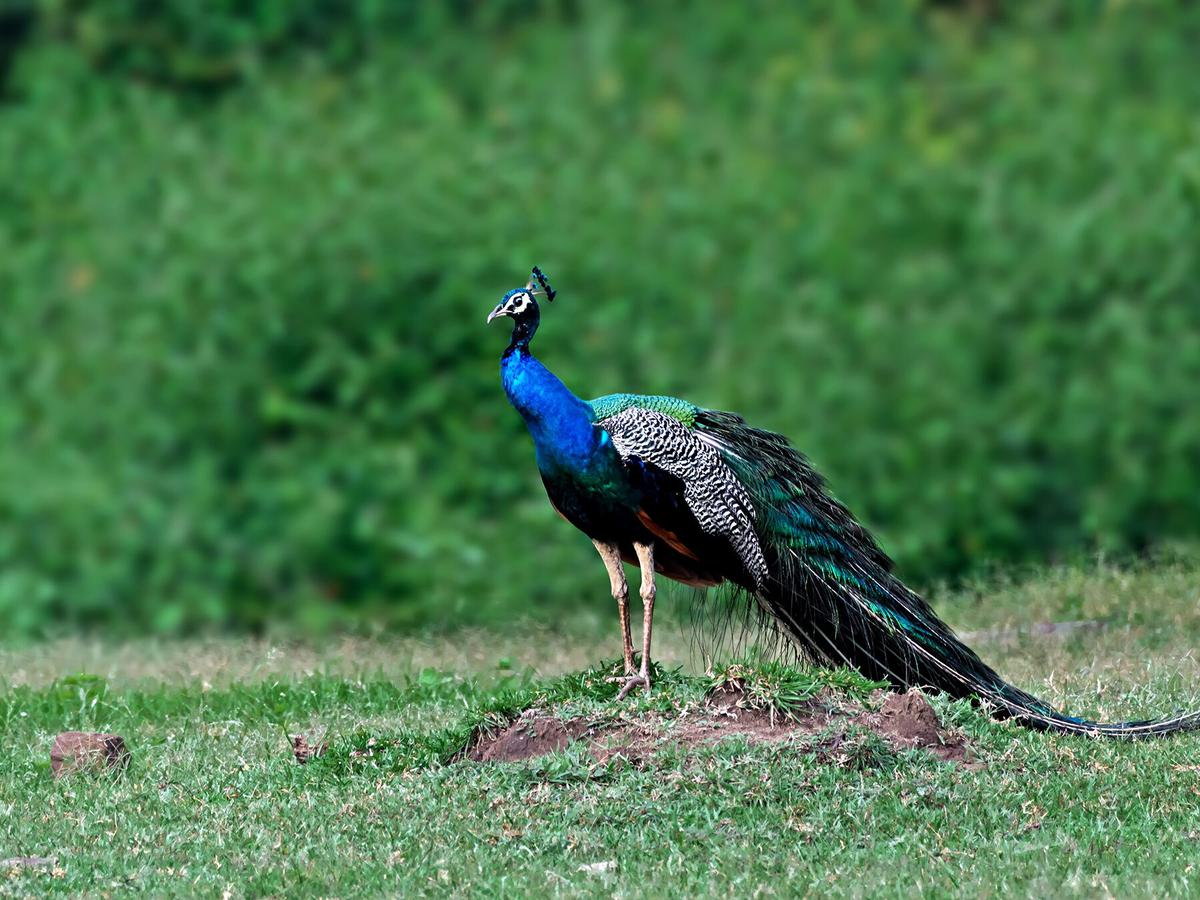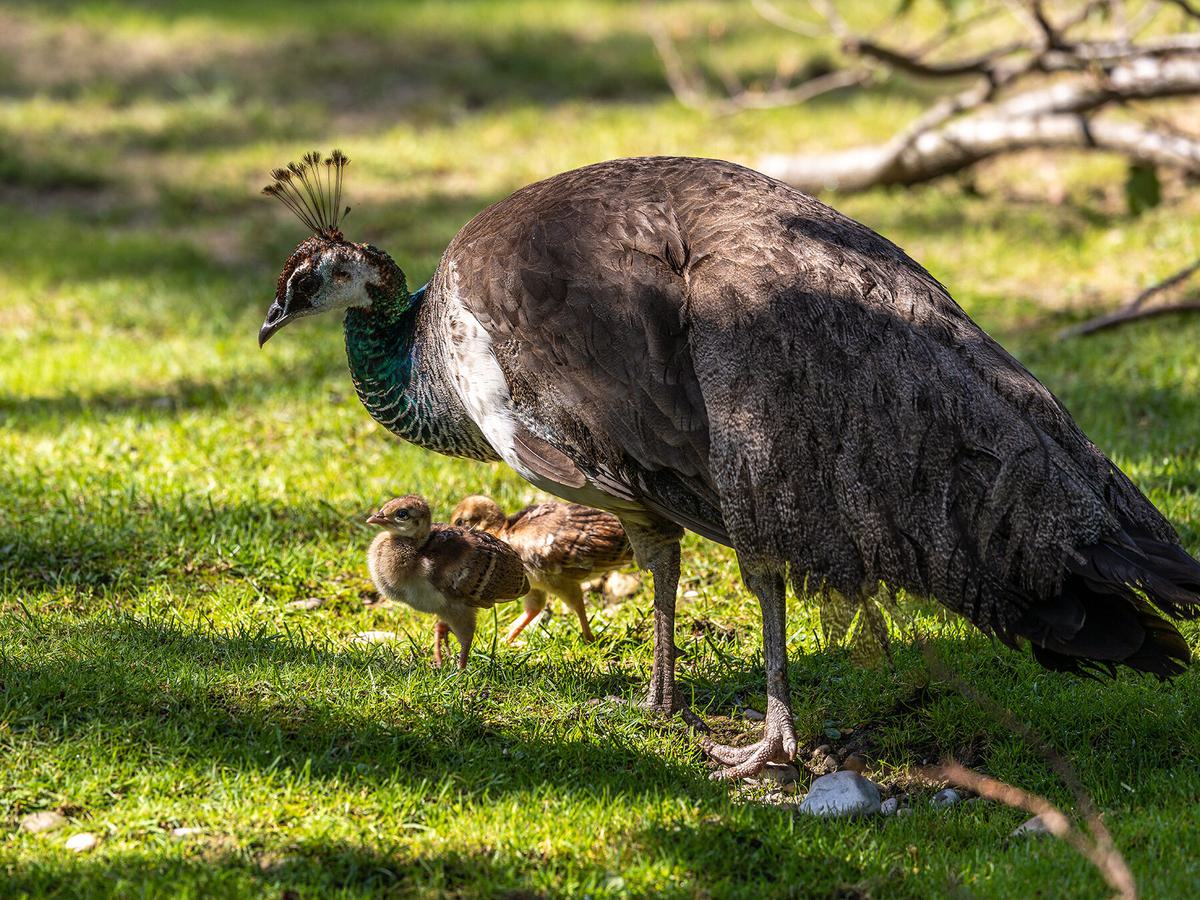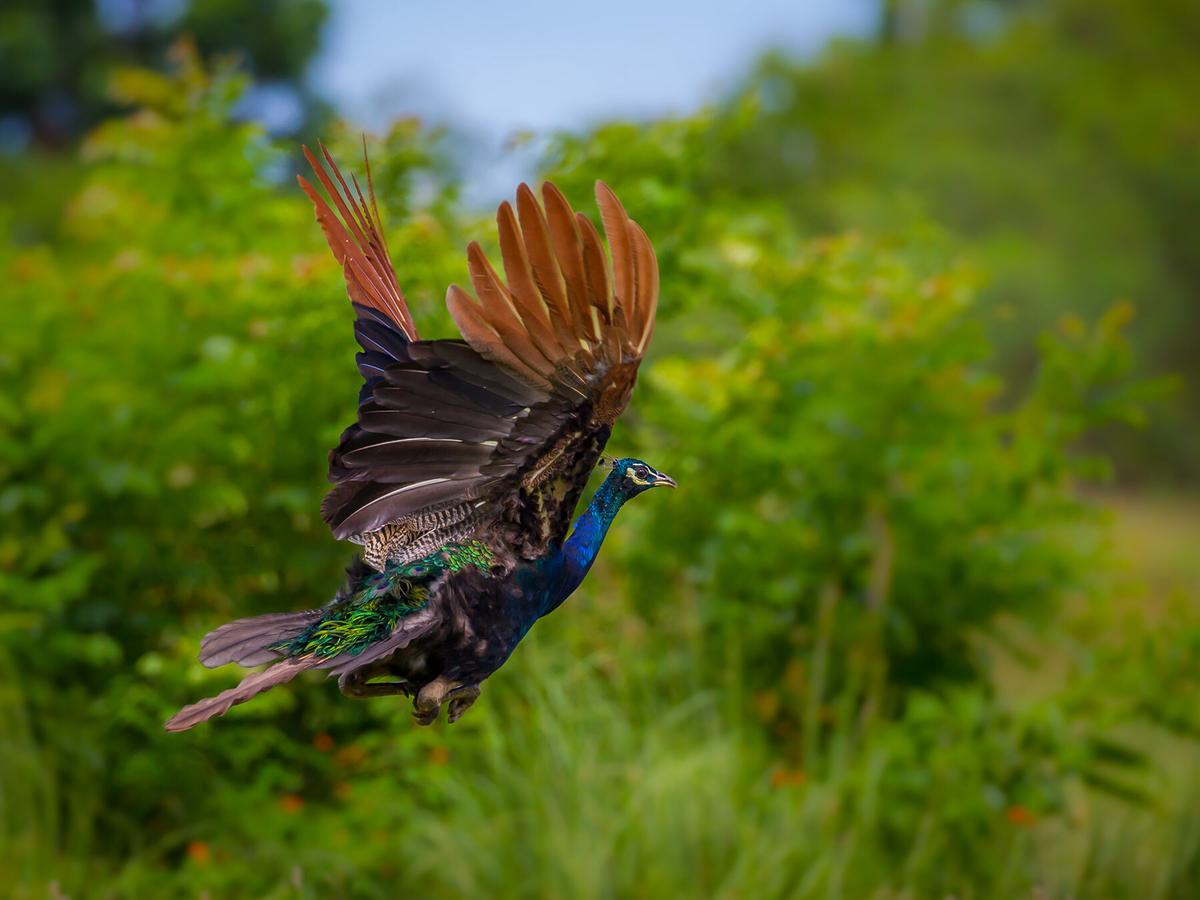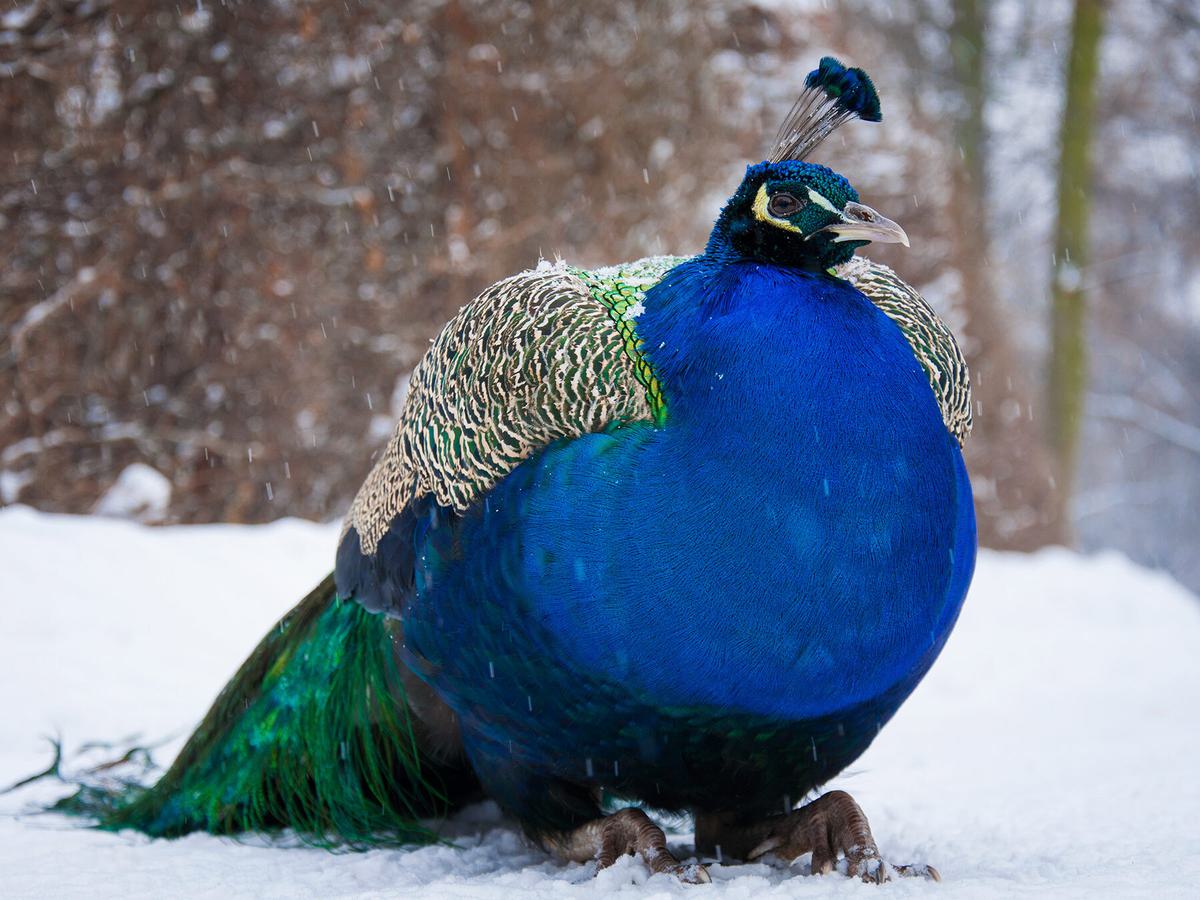Jump to Section
How Long Do Peacocks Live? (Peacock Lifespan)
Last updated: 9 May 2022

Peacocks are male peafowl, of which there are three species. The Indian peafowl is the most famous and widely known peafowl, and the male is much-revered for its spectacular iridescent plumage. There is also the Green peafowl of Southeast Asia, and the uncommon Congo peafowl, native only to the Congo Basin. These are large, impressive birds that are commonly kept as pets, but how long do peacocks live?
Peacocks and peafowl, in general, live for around 10 to 25 years in the wild. There is little reliable evidence of peafowl longevity in the wild. In captivity, there are many anecdotal reports of peafowl living for longer than 30 years, 40, or even 50 years! However, it’s difficult to confirm the accuracy of reports that suggest peafowl live for 50 years.
It’s important to remember that the term ‘peacock’ refers only to male peafowl; the female is called a peahen. While peacocks are often seen in zoos or on the grounds of stately or country homes, they are still a wild species. Even though peacocks have been domesticated for hundreds, if not thousands of years, they’re understudied in the wild.
Read on to learn more about the lifespan of these fantastic birds!

On average, peacocks live for between 10 and 25 years
How can you tell the age of a peacock?
It’s pretty straightforward to tell the age of a young peacock. At 1-years-old, peacocks are yet to develop their characteristic ‘eyes’ that adorn their plumage. Their tail feathers will also be much shorter.
At 2-years-old, the peacock is still yet to develop its full train of plumage, though some eyes will be developing.
At 3-years-old, most peacocks are sexually mature and have their full adult plumage. From there, it’s pretty hard to age a peacock further. In short, full plumage means the peacock must be at least 3-years-old.

Close up of a juvenile peacock (Indian Peafowl)
What is the typical lifespan of a peacock?
Peacocks are capable of living long lives of over 20-years. These are large birds that have few natural predators in some regions, and many more in others. Despite being very well-known in popular culture, peafowl is relatively understudied.
How long do peacocks live in the wild?
Peafowl lifespans in the wild are largely undocumented in scientific literature, but most sources suggest they live for 10 to 25 years, with an average of around 14 or 15 years. Peafowl are powerful birds with large claws and sharp beaks, and they’re capable of defending themselves against most smaller predators.
However, they remain vulnerable to leopards, wolves, dholes (wild dogs), lions, and tigers. Moreover, peachicks (young peafowl) have a high mortality rate of 50% or above, both in the wild and in captivity.

In the wild, the average lifespan of peacocks is around 15 years
How long do peacocks live in captivity?
In captivity, peafowl can live for longer than 20 years. There are many anecdotal reports of peafowl living for 20 to 25 years, with some claiming they owned peacocks that reached the age of 40 or 50! 50 seems like a stretch, but it seems possible based on the lifespan of similar birds.
The trick to peafowl longevity is a super-rich diet full of fresh foods. Peafowl love leafy green vegetables and fruit and have ravenous appetites. They need to be fed at least twice a day.
How do most peacocks die?
Most peafowl die as chicks. Peachicks have around a 50% mortality rate and are very vulnerable until they’re a few months old. While you might expect this to drop when kept in captivity, peachick mortality rates remain high.
This is partly because the adult peahen is not always the most attentive mother in captivity as it is during the wild and may neglect certain chicks. Peachicks are vulnerable to predation, disease, starvation, and attacks by other peafowl or even older chicks.
Once they reach adulthood, peafowl are vulnerable to many diseases, especially when kept in captivity in a farmyard environment. Diseases include avian flu, fowlpox, mycoplasma, laryngotracheitis and various endoparasites.
In the wild, peafowl are predated by various land predators, including lions, tigers, wild dogs, wolves, and leopards. Peachicks are predated by smaller land predators and birds such as eagles and owls.

Peahen with her chicks
What is the life cycle of a peacock?
Peafowl have slow lifecycles. Eggs are incubated for around 28 to 30-days on average. The baby peachicks hatch covered in a fluffy down and can walk and feed themselves within mere hours.
The mother peahen will lead them around the environment and indicate what they should or shouldn’t eat by pecking. Peachicks don’t really fledge as such, as these are primarily ground-roaming birds. Instead, they leave their mother to become independent after around 4 to 6 months.
Peahens are ferociously protective of their chicks in the wild, but captive peahens often have weak motherly instincts. Peafowl take around three years to reach full sexual maturity, at which point the male peacock will have grown the majority of his adult plumage.
- Incubation Time: 28 to 30 days
- Independence: 4 to 6 months
- Sexual Maturity: 2 to 3 years
- Lifespan: 10 to 25 years

Peacock in flight (Indian Peafowl)
What are the predators of peacocks?
In the wild, peafowl face threats from large ground predators, including lions, tigers, wild dogs, wolves, and leopards.
However, it’d be folly to underestimate a peafowl - these are large birds with strong, sharp claws and a sharp, powerful beak. In fact, peafowl will easily dispatch small predators such as non-poisonous reptiles and small-to-medium-sized mammals. Their diets consist of many small snakes, rodents, and small mammals.
In India, peacocks are often kept to deter snakes, including King Cobras! An angry peacock is a force to be reckoned with, and even though these birds are typically docile, they can certainly cause some nasty wounds.
How old is the oldest peacock?
There’s no definitive evidence of the oldest peacock. There are many anecdotal reports of pet and captive peafowl living into their 30s and 40s, which seems possible given some wild specimens live until they’re 25.

A small flock of Green Peafowl
How long can peacocks live without food?
Peafowl need to feed daily to maintain optimum health.
In captivity, peacocks are usually fed at least twice a day. These are large birds that have big appetites to match. In captivity, peafowl are fed a protein-rich gamebird mix combined with a wide selection of leafy greens and fruit. The males need an especially protein-rich diet to help keep their grandiose plumage healthy.
Do peacocks survive winter?
Peacocks generally live in tropical and subtropical regions in the wild, but they are pretty cold-hardy and are kept as pets throughout Europe.
There are peacocks in Scotland - they freely roam the streets of Dunfermline, a quiet Scottish town near Fife! Philanthropist Henry Beveridge brought the Indian peafowl to Pittencrieff Park in Dunfermline in 1905, and though the population dropped to just one peacock, named Clive, they’ve been rejuvenated since 2016.
There are also populations of feral peacocks in Finningley, a small town near Doncaster, UK. They’ve got a bad reputation as vandals, though, and there are repeated calls to oust them from the village! It’s a similar story in parts of Los Angeles, California, where semi-feral and escaped peacocks are often caught ransacking local flowerbeds!

Peacock in the winter snow
Are peacocks protected?
All three species of peafowl are protected to varying extents.
The IUCN Red List of Threatened Species first listed Green peafowl as an “Endangered Species” in 2008, and the Congo peafowl is listed as “Threatened”. The more common Indian peafowl is listed as “Least Concern” but is protected by various laws in India. Pet peacocks in the US and UK are protected by animal cruelty laws.
On this page
- How can you tell the age of a peacock?
- What is the typical lifespan of a peacock?
- How long do peacocks live in the wild?
- How long do peacocks live in captivity?
- How do most peacocks die?
- What is the life cycle of a peacock?
- What are the predators of peacocks?
- How old is the oldest peacock?
- How long can peacocks live without food?
- Do peacocks survive winter?
- Are peacocks protected?





